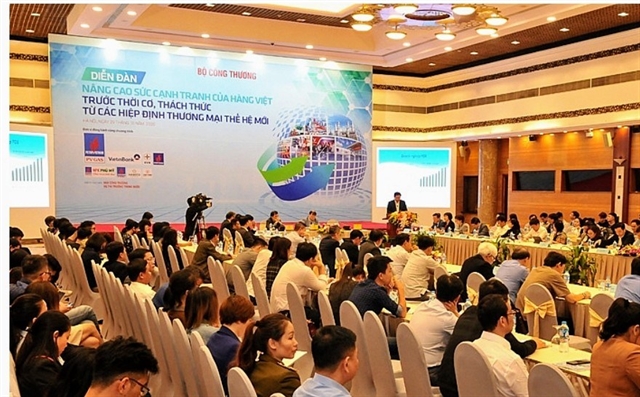 Economy
Economy


|
| The Ministry of Industry and Trade (MoIT) holds a forum discussing the competitiveness of Vietnamese goods and take advantage of new generation trade agreements in Hà Nội yesterday. — VNA/VNS Photo Đức Dũng |
HÀ NỘI — New generation trade agreements could hold the keys to success for many Vietnamese enterprises, especially smaller firms, so they should be making every effort to grasp the opportunities they offer.
The matter was discussed by economists, ministry and department leaders and local enterprises during a forum held by the Ministry of Industry and Trade (MoIT) in Hà Nội yesterday to look at ways to improve the competitiveness of Vietnamese goods and take advantage of new generation trade agreements.
Deputy Minister of Industry and Trade Đỗ Thắng Hải told the forum that Việt Nam was now a member of many new FTAs including the Comprehensive and Progressive Agreement for Trans-Pacific Partnership (CPTPP) and the European Union-Việt Nam Free Trade Agreement (EVFTA).
“Participating in FTAs has helped the import and export market expand and diversify, and the financial services market become more developed with the participation of foreign investors, so institutional systems and policies must be completed to meet the requirements of integration and the implementation of these commitments,” he said.
“Along with the country's accession to the WTO in 2007, FTAs have contributed to boosting the country's GDP to more than 300 per cent and increased import-export turnover by 350 per cent,” he added.
Hải said while the COVID-19 pandemic was ongoing and influencing the global economy, local commodity retail in Việt Nam had emerged as one of the bright spots for the macroeconomy.
According to the General Statistics Office (GSO), total estimated retail sales of consumer goods and services in the third quarter of 2020 reached VNĐ1,305 trillion (US$56.7 billion), an increase of 14.4 per cent compared to the second quarter of 2020 and 4.5 per cent over the same period last year.
In the first three quarters, retail sales of goods reached VNĐ2,907.1 trillion, an increase of 4.8 per cent over the same period last year, GSO data showed.
Hải told the forum: “It is a positive result, clearly demonstrating the role of domestic goods during the unpredictable developments of epidemics and natural disasters. At the same time, it clearly shows the role of Vietnamese products in the domestic market because they are becoming increasingly favoured by consumers.”
According to a MoIT survey, Vietnamese products had become more appreciated and were being given priority by distributors and retailers in Việt Nam. The proportion of Vietnamese products in modern distribution systems was high. Specifically, Vietnamese goods in Co.opmart accounted for between 90 per cent and 93 per cent; in Satra between 90 per cent and 95 per cent; in Vinmart 96 per cent; in Vissan 95 per cent and in Hapro 95 per cent.
Mentioning local enterprises, Trần Duy Đông, deputy minister of Planning and Investment, said: “Despite being an important development engine for the economy and accounting for about 98 per cent of the total number of enterprises, the majority of private enterprises are still small or micro, which prevents them from accumulating capital to invest in innovate technology, expand their production scale or improve management skills and human resources.”
Considering many SMEs still had short-term mindsets, Đông said: “This makes it difficult for them to build trust with long-term partners to develop together for mutual benefit.”
Đông added that Việt Nam had not yet entered the ecosystem and value chain of leading foreign enterprises, saying currently Japanese companies, some of the largest foreign investors in Việt Nam, procured about 32.4 per cent of services and input products from local suppliers while the rate was much higher in China, Thailand and Indonesia.
Đông also said that links between domestic and private foreign enterprises, and between small and large enterprises, remained negligible and limited.
As a member of the Advisory Group of the Government, Trần Đình Thiên said there were strong signs of potential in the country's private sector, but there were still many weak points after 35 years of renovation.
Thiên said the FTAs also posed challenges for Vietnamese businesses because they were having to compete with more imported goods thanks to tariff preferences.
To change this, Thiên said Việt Nam must stop the principle of "ask - give" when allocating resources because it could lead to corruption, waste and distorting the entire market structure.
Regarding local enterprises racing to sell their products at home and overseas, Nguyễn Thị Đông, the owner of Hoa Lan Company which produces natural cosmetic goods, told Việt Nam News: “We face unhealthy competition from fake and smuggled products from other countries.”
Đông, who distribute her products to provinces across Việt Nam through local women's unions, said: “Even though we have more and more customers buying our natural products, it is still difficult competing with fake imported products.”
At the forum, Lương Văn Thắng, chairman of Việt Tiệp Lock Joint Stock Company, one of the biggest lock producers in Việt Nam, said: “To enter export markets like the EU, we have invested in high technology and a protected trademark.”
Thắng said investing in anti-counterfeiting and intellectual property was also a core issue that the company was focusing on to protect the brand and meet the strict standards of the FTAs. The firm planned to apply an anti-counterfeiting authentication process via QR codes to help consumers retrieve information about their locks on their smartphone apps, he said. — VNS




.jpg)